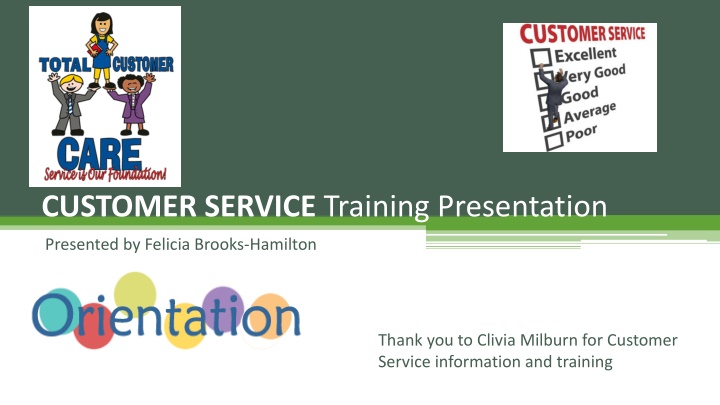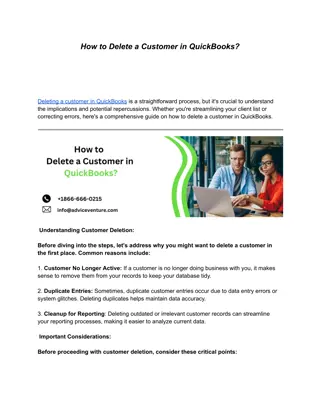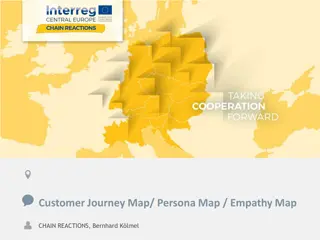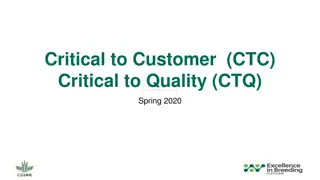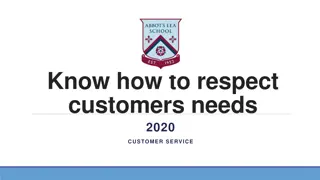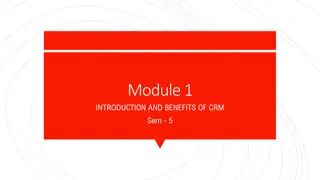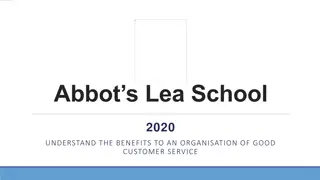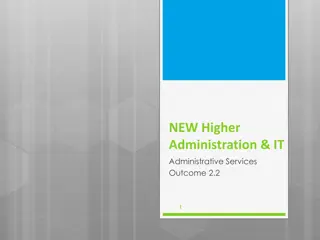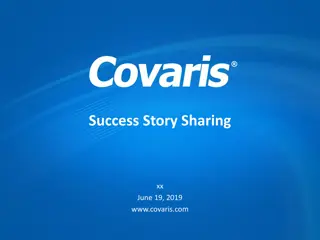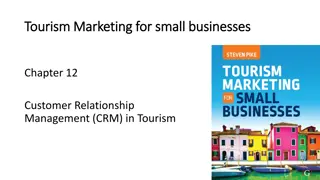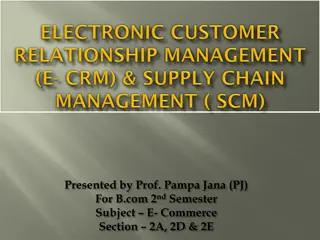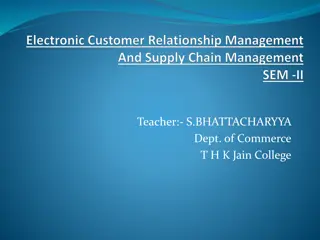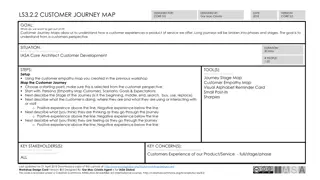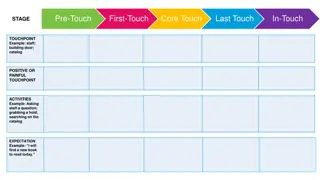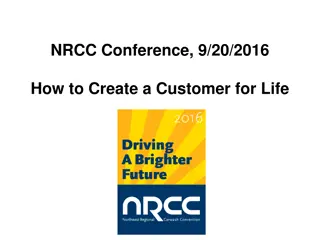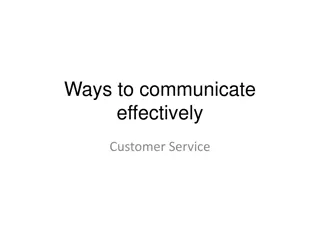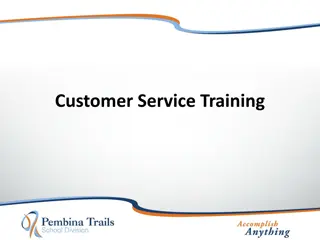Comprehensive Customer Service Training Guide for Project C.A.R.E.S.
This customer service training guide presented by Felicia Brooks-Hamilton aims to ensure world-class service delivery to students, parents, teachers, and stakeholders in educational services. It covers the definition of customer service, its importance, elements, and the mission of Project C.A.R.E.S. to exceed customer expectations and build lasting relationships. Emphasizing the value of good communication, etiquette, and professionalism, the guide underscores the significance of maintaining positive customer relations for long-term success.
Download Presentation

Please find below an Image/Link to download the presentation.
The content on the website is provided AS IS for your information and personal use only. It may not be sold, licensed, or shared on other websites without obtaining consent from the author.If you encounter any issues during the download, it is possible that the publisher has removed the file from their server.
You are allowed to download the files provided on this website for personal or commercial use, subject to the condition that they are used lawfully. All files are the property of their respective owners.
The content on the website is provided AS IS for your information and personal use only. It may not be sold, licensed, or shared on other websites without obtaining consent from the author.
E N D
Presentation Transcript
CUSTOMER SERVICE Training Presentation Presented by Felicia Brooks-Hamilton Thank you to Clivia Milburn for Customer Service information and training
Project C.A.R.E.S. would like to ensure that we provide world class customer service to all students, parents, teachers, other staff and stakeholders involved in our service delivery of educational services. As a result, we have created this customer service training guide for all our program staff. What is Customer Service?
What is Customer Service? 1. Customer service is the provision of labor and other resources, for the purpose of increasing the value that buyers receive from their purchases and from the processes leading up to the purchase. 2. Customer service is changing the mindset of the customer by building rapport & making the customer feel happy about interacting with the agency resulting into a positive attitude of the customer towards the agency in future as well. 3. Customer service is helping the customer get what he/she wants, going the extra mile to solve his query in a caring & efficient manner to achieve higher customer retention. Good communication skills, etiquette & mannerisms are required for good customer service.
What is Customer Service? 4. Customer service is assistance that a company provides to the people who buy or use its products or services 5. Customer service is meeting the needs and desires of any customer 6. Customer service is the act of taking care of the customer's needs by providing and delivering professional, helpful, high quality service and assistance before, during, and after the customer's requirements are met
Reputable companies use customer service to help set them apart from their competition, especially if product and pricing are not so unique Project C.A.R.E.S. mission is Delivering world class customer service that exceeds our customers expectations. This means having the capacity to provide a positive memorable, unforgettable experience to every individual we come in contact with (parent/legal guardians, students, teachers, vendors, community partners, staff, contractors, and stakeholders involved with our agency). It is our constant endeavor to maintain and enhance the trust of our customers, promote goodwill in our working environment and ensure transparency in all our business transactions. Keep in mind It's a known fact that it costs several times more to attract a new customer than it is to keep an existing one. So it's much wiser for us to maintain focus on customers that we already have and to build long-term positive relations than it will be to attract new ones
Who is the Customer: 1. Customer (sometimes known as a client, buyer, or purchaser) is the recipient of a good, service, product or an idea 2. General: A party/individual that receives or consumes products (goods or services) and has the ability to choose between different products and suppliers. 3. A customer is anyone who receives a product either a good or a service from an organization. 4. A customer/buyer s primary responsibility is obtaining the highest quality goods at the lowest cost. This usually requires research.
The Customer is the RATER of our service delivery. Below is a listing of the criteria that Project C.A.R.E.S. Customers use to evaluate their service experience with our agency: Reliability: Provide a consistent level of service that meets or exceeds expectation. Assurance: Trust our business to convey honesty and competency in all areas delivering educational services.
The Customer is the RATER of our service delivery. Professionalism: In all aspects of our business to include physical environment, service delivery products and staff Empathy: To show sensitivity and understanding of somebody else s feelings, thoughts and difficulties Communication: Prompt in solving problems, and concerns t the best of our ability and the satisfaction of the customer.
Characteristics of Good Customer Service: Some characteristics of good customer service include: Promptness: Promises for delivery of products must be on time. Delays and cancellations of products should be avoided. Politeness: Politeness is almost a lost art. Saying 'hello,' 'good afternoon,' 'sir , and 'thank you very much' are a part of good customer service. For any business, using good manners is appropriate whether the customer makes a purchase or not.
Characteristics of Good Customer Service: Professionalism: All customers should be treated professionally, which means the use of competence or skill expected of the professional. Professionalism shows the customer they're cared for. Personalization: Using the customer's name is very effective in producing loyalty. Customers like the idea that whom they do business with knows them on a personal level..
When Dealing with a Customer: 1. Understand the problem Let the customer speak without interrupting. Note the important facts and repeat them to be sure you got it right. Say things such as just to confirm..... is this what you are in need of ? 2. Identify the Cause Identifying the cause often means accepting that Project C.A.R.E.S., not the customer or stakeholder, is responsible for the problem. Isolate the problem. 3. Propose Solutions: As the customer if he or she has a clear idea of how they want the situation to be resolved. Either agree or work with them to finalize a plan that works for the customer and the company.
When Dealing with a Customer: 4. Solve the Problem: After corrective action ask the customer if they are pleased with the way the problem was resolved. Apologize for the trouble and any inconvenience caused
Here are v very good reasons to improve customer service skills and be more professional in dealing with all customers: 1. Less Job related stress When you sharpen your customer service skills and techniques you can easily deal with most issues and customers decreasing unpleasant interactions, thus ultimately less job related stress. 2. Career Advancement: If you enjoy helping others and can draw satisfaction from helping your customers in a professional manner, keep in mind that colleagues, supervisors, and managers in your company are aware when customers ask for you by name because you do a great job. Then you will have a better chance of recognition. 3. Your Job becomes a source of satisfaction: When you provide great customer service to a customer who needs help or has a complaint that you resolved and very courteously handled that angry customer, you feel that you are making a difference. You can be one of few people lucky enough to experience how rewarding it is to take satisfaction from every successful customer interaction. Regardless of your reasons, learning professional customer service techniques and serving your customers better can be very rewarding.
Service Overview from a Customers Perspective: 1. Speed: Is staff knowledgeable and able to give spontaneous responses or able to secure the answer to questions when in doubt. 2. Communication: Conscious effort to do a good job of sharing with families and customers everything they need to know to make an informed decision. 3. Follow-up: All our families and stakeholders should be given all the pertinent information of a person to contact if they need help or have additional questions. Staff are given guidelines to help them problem solve. 4. Complaints: Prompt handling and disposition of complaints. Make it easy for them to complain if needed. Staff are given the freedom to problem solve to reach the best solution. There is immediate access to administrative staff. Consistent follow-up of all customers after discharge to ensure customer satisfaction. 5. Retention: Establish and maintain all relationships with customers, families and stakeholders through emails and newsletters. Also staff longevity for continuity. Employee Monitoring: Encourage staff to provide good customer service. Customer feedback is shared and staff is confronted when not meeting service standards. Positive rewards are shown when staff uses initiative and good customer service.
How you can help Project C.A.R.E.S. GROW as a Service Provider Questioning is an essential skill for all of us being able to provide excellent customer service. We have designed the following questioning model to help you identify the exact needs of the consumers we serve. 1- Goal: Find out your customer s ultimate goal. First you need to agree with your customer and clearly understand his/her ultimate goal from this visit/call, what type of service/product is he looking for? So the customer s specific, measurable, and realistic goal is very clear in your head. In doing so it would be useful to ask questions like: Why are you shopping for a new agency? What would you like the new agency to do to help assist you? What problems are you currently having with your services? 2- Reality: Examine the customer s current reality and situation. Next you need to find out about the customer s current situation by clearly understanding what type of service is he/she getting now.
In doing so it would be useful to ask questions like: what type of service are you receiving now? What services have you receive in the past? How was your experience with the last service you used? 3- Options: Explore available options together. Once you clearly understand your customer s current reality and situation, you need to explore together all the options that can be offered to help satisfy the customer s needs. After explaining all the different options it would be useful to ask questions like: Do you agree that our second option would be the most suitable to your needs? Do you wish us to customize this option further to better fit your need?
4- Will: Take responsibility and gain commitment from the customer. By examining the current reality and exploring all available options, both you and your customer will have a good idea of how he/she can achieve the goal, solve the problem or provide the appropriate services. So the final step would be to show your customer that you are committed to the solutions agreed and to get a commitment from the customer that he/she is ready to go for the new agreed options/solutions within an agreed upon timeframe. In doing so it would be useful to ask questions like: Would you like me to go ahead and do this for you right now? When is a convenient time for you to go ahead and do this? What s the best time for you to start this process?
DIFFUSE ANGRY CUSTOMERS: 1-Empathize Show acceptance not necessarily agreement for what the customer said or experienced. Empathy vs. Sympathy Sympathyinvolves identifying with, and even taking on, another person s emotions. A sympathetic response is, I m really angry about those services too. Empathymeans acknowledging and affirming another s emotional state. An empathetic response is, I can understand why that makes you angry.
DIFFUSE ANGRY CUSTOMERS: What s the Difference? Responding to customers with sympathy getting as upset as they are puts you on an emotional roller coaster and can leave you worn out and frustrated at the end of the day. The trick is to be emotionally aware and sensitive without becoming too emotionally involved. When you respond with empathy, you stay calm and in control of yourself. Only then you become at your absolute best: ready, willing, and able to help your customer meet his needs or solve his problem. Showing empathy for customers allows you to be professional and caring at the same time. It also makes customers feel that they are important and what they are saying matters. Empathy cannot be handed out by a machine; it s something one person does for another
DIFFUSE ANGRY CUSTOMERS: 2-Apologize Express sincere personal regret for the bad experience. If appropriate apologize on behalf of the organization without blaming anyone 3-Appreciate Show appreciation for customer feedback or actions that help you understand and resolve the situation . 4-Assure Let the customer know you are ready and willing to help and will personally follow through
DIFFUSE ANGRY CUSTOMERS: 5-Confirm Check your understanding of what the customer said or what actually happened. 6-Selectively Agree Agree with at least one thing the customer said. 7-Set Limits Make statements that let the customer know that certain words or behaviours are beyond the limits of cooperative or productive business conversation (always use positive supportive tone of voice)
Forbidden Service Phrases PHRASE "I Don't Know" "We Can't do that" SUGGESTED ALTERNATIVES "Gee that's a good question, let me check and find out "That's a tough one, let us see what we can do " - then find an alternative solution Soften the request with phrases like "you'll need to " or " here's how we can help you with that " or "The next time that happens, here's what you can do ." "It may take me two or three minutes (or however long it will really take) to get that. Are you able to hold/wait while i check?" 'You'll have to " "Hang on a second; I'll be right back" If you think before you speak, you can turn every negative response "we aren't able to refund your money, but we can replace the product at no charge." "No" when used at the beginning of any sentence
NEVER SAY ANY OF THE FOLLOWING TO A CUSTOMER/STAKEHOLDER: "It's not my Job." "I'm afraid there's no one here who can help you." "It's not our policy to ...." "If only you'd ..." "Sorry, you've got the wrong department." "Are you sure you followed the instructions?" "I don't see what the problem is?" "You're not the first to complain about this." "Please hold just a second" - and then you take forever
BUILDING CUSTOMER/STAKEHOLDER RAPPORT 1. Smile Try to smile more when you are with customers, guardians, stakeholders and families. The more you show your enjoyment in the relationship, the more at ease and comfortable your customer will be. 2. Genuinely Compliment your Customer and Stakeholders Few people actually do this. If you cannot genuinely compliment , don t bother trying. Nothing kills rapport more quickly than a phony compliment. 3. Find Commonality Try to find something you share with your customer to talk about and break all ice. 4. Take a Genuine Interest in your Customer, Family, Foster Child & Stakeholder Most people see through feigned interest, and when they do, you ll fail to build the rapport you desire. Choose the right time to ask about their hobbies, family, interests, school, where they live, which sports team they support etc.
5. Listen Carefully Another strategy to develop rapport with families and guardians is to listen actively, to give them your total undivided attention. Avoid interruptions and distractions like emails, cell phones, knocks on the door, and ringing telephones. Make your customers feel as if they are at the centre of your universe. You not only need to listen to what your customers are saying, you need to listen actively. Active listening means paying attention, asking questions, restating the message to make sure you understand what the customers are saying, and looking and listening for the emotions behind the words. Speak your customer s Language: Don t try to impress your customer by using a lot of Jargon and technical terms from your industry, you will only end up confusing your customer and making him/her feel uncomfortable or worse making them feel ignorant. Assume your clients know very little about what you do. Use clear and simple language to express what you have to offer or explain. Don t be afraid to ask questions if you don t understand some area of their business. Use analogies to their business to relate what you re offering to what they do every day and to their specific needs.
Dont disagree immediately Another way for you to kill rapport is to immediately disagree with a customer or to appear argumentative. While agreeing with your customer can be a powerful tool for building rapport, disagreeing can be an equally powerful tool for destroying rapport. When customers say something you agree with, let them know you clearly and emphatically agree: I couldn t agree with you more. When customers say something you may not agree with, don t disagree immediately, no matter what you think. Focus instead on where you do agree, or try to see the customers point of view. Consider saying something like, I agree with you that . . . or I can appreciate how you may feel or I never thought of it that way or That s an interesting way to look at it. Choose your battles When you do disagree with a client, make sure that you oppose the point, not the person. And keeping in mind that any battle with a customer has one winner and that's the customer, he/she can always take their business somewhere else and then you lost. You will not build lifetime rapport with customers by making them feel that they re not intelligent or that they ve made poor choices. You will build rapport by gently pointing out faulty thinking, sharing your expertise and offering creative solutions.
CUSTOMER SERVICE SIGNATURE PAGE I hereby acknowledge that I have received the Project C.A.R.E.S. Customer Service Training dated October 01, 2018 and I have read and understand the information contained in the Training Presentation represents customer service expectations to all students, parents, teachers, other staff and stakeholders Print Name: __________________________ Signature: _________________________ Date : ____________________________
